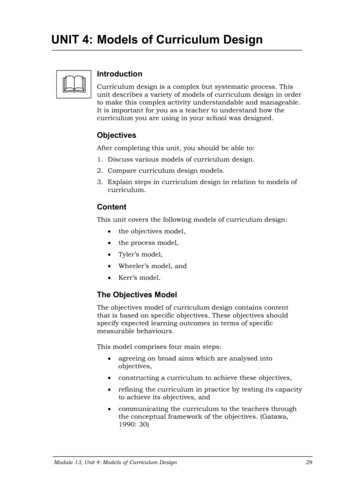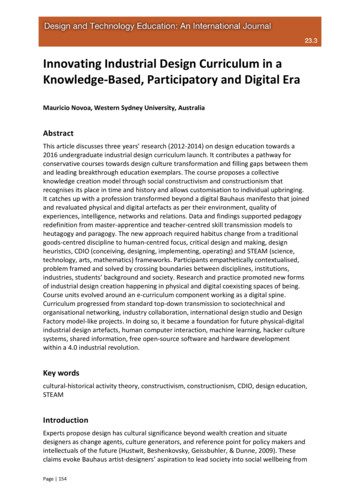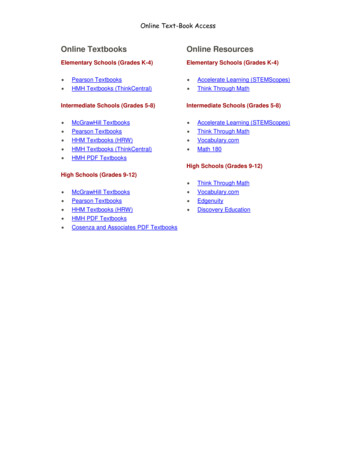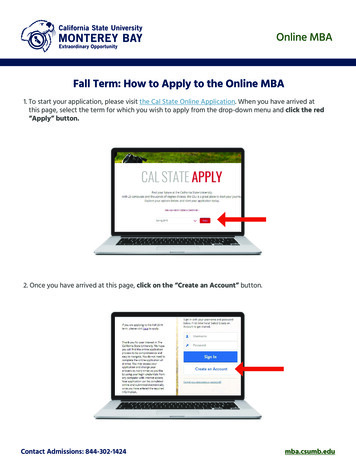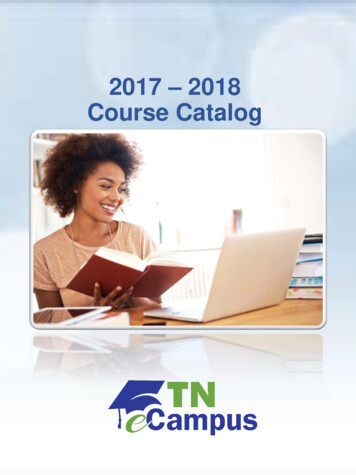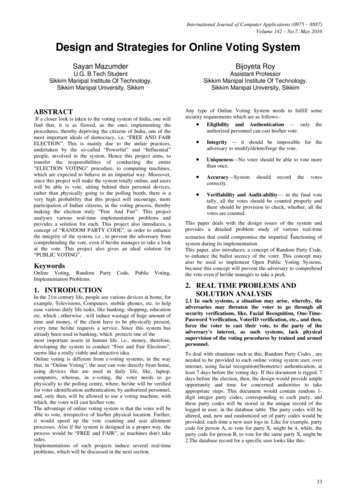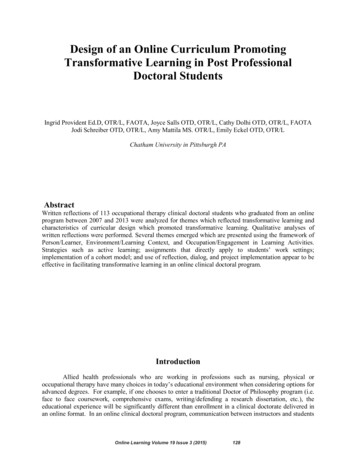
Transcription
Design of an Online Curriculum PromotingTransformative Learning in Post ProfessionalDoctoral StudentsIngrid Provident Ed.D, OTR/L, FAOTA, Joyce Salls OTD, OTR/L, Cathy Dolhi OTD, OTR/L, FAOTAJodi Schreiber OTD, OTR/L, Amy Mattila MS. OTR/L, Emily Eckel OTD, OTR/LChatham University in Pittsburgh PAAbstractWritten reflections of 113 occupational therapy clinical doctoral students who graduated from an onlineprogram between 2007 and 2013 were analyzed for themes which reflected transformative learning andcharacteristics of curricular design which promoted transformative learning. Qualitative analyses ofwritten reflections were performed. Several themes emerged which are presented using the framework ofPerson/Learner, Environment/Learning Context, and Occupation/Engagement in Learning Activities.Strategies such as active learning; assignments that directly apply to students’ work settings;implementation of a cohort model; and use of reflection, dialog, and project implementation appear to beeffective in facilitating transformative learning in an online clinical doctoral program.IntroductionAllied health professionals who are working in professions such as nursing, physical oroccupational therapy have many choices in today’s educational environment when considering options foradvanced degrees. For example, if one chooses to enter a traditional Doctor of Philosophy program (i.e.face to face coursework, comprehensive exams, writing/defending a research dissertation, etc.), theeducational experience will be significantly different than enrollment in a clinical doctorate delivered inan online format. In an online clinical doctoral program, communication between instructors and studentsOnline Learning Volume 19 Issue 3 (2015)128
is mediated through technology rather than traditional classroom interactions. Dialogue in onlineeducational environments may be conducted asynchronously—i.e., postings on a course website can beread at a different time by each party—or in synchronous formats—i.e., auditory and/or written words areheard or read in real time. As a result, student learning in clinical and online doctoral programs will beaffected by the structure of online curricula and instructors’ abilities to guide student learning (Simons,Baron, Knicely, & Richardson, 2001).For students pursuing a post-professional degree online, there are both benefits anddrawbacks. Hollis and Madill (2006) described the perceived advantages of online learning as increasedchoice and flexibility, less disruption to personal lives, and decreased travel time. In a study of nursingstudents in a hybrid post-professional program, Smyth, Houghton, Cooney, and Casey (2012) foundonline learning—in addition to its advantages—posed a number of challenges. These included a sense ofisolation and lack of community, a lack of feedback, technical problems, and a sense of invasiveness.Online university courses and programs are increasingly available. Over six million students tookan online university level course in 2010. This is a 10% increase from the previous year (Statistic BrainResearch Institute, 2013). Availability of online education and enrollment is expected to continue toincrease. Given the growth of online educational opportunities it is important to understand whateducational practices effectively enable doctoral students to develop and learn. Additionally, iftransformative learning is a desired outcome, understanding the theory and its relationship to the structureof a curriculum to foster the perspective shift and preparation of doctoral students is imperative. Thestudy of transformative learning in the online environment is a focus for contemporaryresearch. Specifically, the aim of this paper is to further the understanding of how the curricular structureof an online post professional occupational therapy doctoral program contributed to the transformativelearning experiences of students enrolled in the program.Literature ReviewTransformative learning theory focuses on an adult learner’s ability to reflect and make newmeaning of experiences and environments (Allen, 2007). The theory has evolved over the past threedecades as others (Benson, Hewitt, Heagney, Devos, & Crosling, 2010; Boyd, 2009; Matthew-Maich,Ploeg, Jack, & Dobbins, 2010; Taylor, 2007) have expanded upon the seminal work of Mezirow (1997).Guided by this theory, the student often experiences change as the result of a multiple step processfrequently characterized by a disorienting dilemma, followed by the use of active learning, and reflection.The dilemma can serve as a catalyst for learners to examine their assumptions and beliefs throughengagement in self-reflection and discourse with others related to changing their view. According totransformative learning theory, this process results in the reorganization of perspective with action topromote change (Santalucia & Johnson, 2010). The product is a learner who emerges with skills to effectbroader change.The scientific literature includes outcome studies of doctoral students’ transformative learningexperiences. Boyer, Maher, and Kirkman (2006) identified evidence of transformative learning in anonline graduate course by using systematic content analysis of students’ written reflections. Theirfindings suggested that phases of transformative learning were evident in student comments and thatfundamental changes in ideas, beliefs, habits, or assumptions occurred for approximately one-fourth ofstudents in relation to course workload, competence with technology, social role priorities, andcollaborative learning. The role of the instructor was identified as vital to facilitation of transformativelearning.Online Learning Volume 19 Issue 3 (2015)129
According to Henderson (2010) in a synthesis of research related to transformative learning in theonline environment, critical reflection, discourse, trusting relationships, and support are the maincomponents in fostering student progression towards transformative learning. The learner experiencing adilemma is challenged to question previously held assumptions and to consider alternatives throughexploratory prompts and critical reflection (Matthew-Maich, et al., 2010; Mezirow, 2000). The role of theonline educator using critical reflection and facilitating discourse is to foster the development of thelearner by creating opportunity for the inquiry process, thus enabling the student to move beyondtechnical procedures. This critical reflection provides an opportunity for learners to reflect on experiencesand assumptions resulting in a shift in thinking, or transformation (Mezirow, 1997). It is postulated thatreflective writing can facilitate introspection and thoughtful consideration of new ideas and can be astrategy to promote reflective practice (Langley & Brown, 2010; Schön, 1987). Other authors considerdiscourse with peers related to self-reflection on beliefs, feelings, and values an essential component ofcritical self-reflection and promotion of transformative learning (Meyers, 2008; Olaniran, 2005).Trusting relationships and establishing support have been cited as important elements infacilitating transformative learning processes in online environments. In a survey of 59 doctoralgraduates, Stevens-Long, et al. (2012) reported transformative learning outcomes that surpassedintellectual growth. Participants identified key experiences perceived to be linked to these outcomes as“.interpersonal relationships (faculty-student and student-student) characterized by community support,collegial relations with faculty, inclusion of diverse people and perspectives, and bonding with fellowstudents: curricular content and structure that lead to a transformation in perspective and worldview” (p.191).While not cited in the literature related to online learning environments, Cranton and Carusetta,(2004), state:In the final phases of transformation, the learner tries out new roles in an attempt to test andvalidate new frames of reference. The learner can only achieve this role-playing by engaging incritical discourse with others and then reflecting on that discourse. Once a new role has beentried and validated, learners can then reintegrate the new learning and way of knowing into theirprevious understanding, reconciling the old and new. (p. 24)The literature related to online learning seems to be lacking with regard to the final step of thetransformative process, trying new roles and taking action. Specifically how can an online program fosterthe ability of students to take action and try out new roles while receiving the critical reflection, discourse,trusting relationships, and support from their peers and instructors?In an effort to understand the effects of an online program’s curricular sequence and the ability ofthe instructors to promote transformative learning, the following questions were used to guide theresearch:Question 1: What is the evidence of transformative learning in the written reflections ofoccupational therapy students upon completion of a post-professional online doctoral program?Question 2: How does the design of an online doctoral program facilitate a student’s progressionthrough the stages of transformative learning?Online Learning Volume 19 Issue 3 (2015)130
Educational Context of the OTD ProgramIn 1994, the post-professional clinical doctorate in occupational therapy (OTD) emerged as anoption for credentialed occupational therapists to advance their understanding of the profession. Thedoctoral program at this university is an online post-professional OTD which is designed as a cohortmodel for professionals working in the field. New cohorts begin each fall and spring term, with studentsassigned to their cohort upon admission to the program. Each cohort is maximized at 15 students. Incircumstances where more than 15 students are accepted for a start term, two cohorts are created withequal numbers of students. When two cohorts exist in a term, consideration is given to dividing thestudents to maximize diversity in terms of practice settings, years of experience, and writing proficiencyas demonstrated in the application essay. A cohort model was chosen in an effort to create a communityof learners from geographically and professionally diverse areas. The cohort group of students remainstogether throughout the program, which includes ten courses over a 16-month time frame. Each course inthe curriculum is linked and courses are delivered asynchronously through the Moodle web-basedplatform. The majority of the OTD students are employed full time and work in a variety of settingsincluding academia, community, and hospital based facilities. Each course in the OTD curriculum isdesigned to foster active learning by including assignments that can be applied directly to each student’sarea of professional interest/practice. All courses include ongoing discussion forums facilitated byinstructors and multiple opportunities for students to engage in reflective writing activities and peerreview processes. Students are enrolled in two or three courses per semester with two visits to campusrequired over the entire program—one visit occurs during a leadership course, and the second visit occursat the conclusion of students’ capstone projects. The visits are intended to facilitate a sense of communityamong the cohort members as well as to provide a connection to the university.The OTD program was purposely designed to facilitate a change in the learner to enable eachstudent to translate the best available evidence to occupational therapy practice. As part of the doctoralrequirements, OTD students are required to complete a capstone project, which includes development,implementation, and evaluation of an evidence-based project. This process occurs over four academicsemesters and culminates in an on campus visit where students present their capstone projects via bothoral and poster presentation.During the first evidence-based practice course which occurs in the first semester of the program,students propose a focused question that addresses a dilemma in their workplace and each studentperforms an independent preliminary search of the evidence. In the next semester, students systematicallygather literature that provides possible resolutions to their dilemma and complete assignments that beginto allow them to demonstrate skill in understanding the scientific literature. While completing theseassignments, students engage in facilitated discussions related to the new skill set of obtaining,understanding, and translating the research to resolve their workplace issue. Students write a synthesis ofthis body of evidence and engage in a formal peer review and feedback process with students in theircohort. Thus, critical reflection and discourse are inherent in the program design through both the writingassignments and interaction with peers and instructors. The curricular intention is to promote habitformation in critical reflection, and the practice of sending the student back to the published literature andguiding him or her to articulate newly acquired knowledge and shifting perspective.The culmination of this first part of the transformative process results in the development of theaction plan for an individualized capstone project to be carried out in the student’s workplace. Thespecific objective of this early portion of the online program is the development of professional habits andbehavior patterns within a culture of support and trust. In the remainder of the online program, studentcapstone projects are implemented in their unique work context. Students continue to be supported bytheir peers in the cohort as well as the instructor who continues to require online participation throughdiscussion prompts. This active discussion and reflection is designed to have students share theirOnline Learning Volume 19 Issue 3 (2015)131
experiences in trying out their new roles in their worksites. As the outcomes of their individual projectsare shared online with their trusted peers, students have the opportunity to integrate this new learning intotheir previous ways of understanding their role in their own workplace. This process culminates withstudents formally sharing both the process and results of their implemented project during the second oncampus visit.MethodParticipantsOne hundred thirteen occupational therapy doctoral students graduated from the post-professionalOTD program from April 2007 to April 2013 and were included in this study. This university’sInstitutional Review Board (IRB) reviewed and approved the research proposal for this project. Studentidentifiers were removed from students’ reflections and replaced with a code number to ensureconfidentiality. Retrospective review of the data was considered ethical in protection of human subjectsand approval was granted through exempt level review.Data CollectionAs part of the capstone project, students wrote reflections about their experiences in theprogram. These reflections were published in their capstone manuscripts. Their reflective writing wasthe last section of their capstone project and was written in fulfillment of an open ended writing promptrequesting students write an epilogue of their journey. As a way of having students critically reflect, aportion of the last chapter of the written capstone project is titled “Final Reflections” in which studentsreflect on their experience in the program. Review of these written reflections formed the basis for thiscurrent study exploring transformative learning in this online doctoral program.Members of the program faculty familiar with transformative learning theory noticed that somestudents described experiences suggestive of disorienting dilemmas, critical self-reflection, alteredperspectives, and plans for acting differently in the world and their workplace. This recognition ledmembers of the faculty to methodically analyze the reflections for themes related to transformativelearning.Data AnalysisThe framework of the Person-Environment-Occupation (PEO) Model (Law et al., 1996) wasused as the first level of systematically categorizing the written reflections considering the elements thatimpacted the students’ performance. This occupational therapy model asserts an individual’sperformance emerges as the result of the “transaction that occurs among the person, environment, andoccupation in which the person engages” (p. 17). In doing so, the framework of the model also offersconcrete parameters for defining each of the three components (person, environment, and occupation).The person in the PEO model is considered to be a composite of physical, cognitive, andaffective components that enable the individual to do, think, and feel. The person in this study is theOTD student (learner) who can be described as being a “dynamic, motivated and an ever-developingbeing, constantly interacting with the environment” (Law et al., 1996, p. 17).The PEO model characterizes the environment, as “the context within which the occupationalperformance of the person takes place” (Law et al., 1996, p. 17). In this study, the environment is theonline learning context. The environment (learning context) includes consideration of cultural,institutional, physical, and social elements that have the potential to impact one’s performance.Online Learning Volume 19 Issue 3 (2015)132
Occupations in the PEO model “include activities and tasks done to complete a purpose” (Lawet al., 1996, p. 17). Amidst a variety of formal definitions in the occupational therapy literature,occupations have been defined as “ activities that bring meaning to the daily lives of individuals andenable them to participate in society” (American Occupational Therapy Association, 2011). Theoccupation of interest in this study is the student's active participation and learning in the OTD program.The theoretical thinking behind using the PEO model for categorizing the student reflections isthat when the three components of the model are working in synchrony, the individual is able tosuccessfully engage in desired occupations within the contextual confines associated with theoccupation. This engagement is referred to as occupational performance. In this study, the online OTDprogram, a deliberately structured learning process, is intended to influence the way the student thinksabout and engages in new ways of providing evidence-based occupational therapy services at thestudent’s worksite. The PEO model further asserts if one or more of the three components (Person,Environment or Occupation) negatively impacts the “fit” with the others in some way, occupationalperformance may be impacted. If the three components are working together with good “fit” the authorsassert that transformative learning may result.Student reflections were analyzed and categorized into reflections about the Person/Learner,Environment/Learning Context, and the Occupation/Student Engagement with the Curriculum/ActiveLearning. These three distinct areas allowed for the thematic analysis of student reflections as pertainingto: a) statements which reflected transformative learning experiences through the unique perspectivechanges in person (Learner), b) comments about the online curriculum (Learning Context), and c) whatthe students did as a result of the design of the online curriculum (Active Learning).Of the 113 reflections which ranged in length from one to four pages, 79 (70%) revealedreflective writings that were independently judged by five faculty members to include statements oftransformative learning. These student reflections contained unsolicited evidence, which revealed a shiftin thoughts and/or feelings demonstrating the student’s transformative learning as a result of theeducational process of the online doctoral program. These statements included newly revisedunderstandings of self and/or relationships with others as well as a plan to apply new perspectives to theirpr
Jodi Schreiber OTD, OTR/L, Amy Mattila MS. OTR/L, Emily Eckel OTD, OTR/L Chatham University in Pittsburgh PA Abstract Written reflections of 113 occupational therapy clinical doctoral students who graduated from an online program between 2007 and 2013 were analyz
